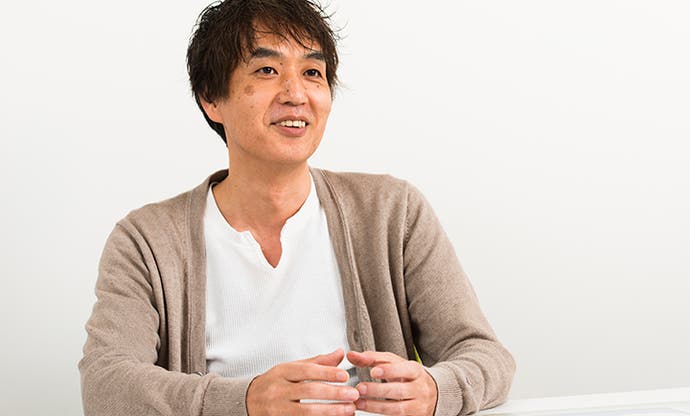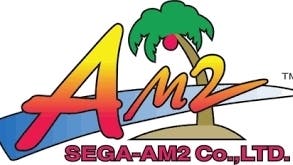Tales from inside Sega AM2's top-secret studio
Magical sound shower.
You might not have noticed, but late last year a small piece of Sega history quietly slipped away. The company's Ota headquarters, once immortalised as the EVIL headquarters in 1994's Virtua Cop, was where so much of the magic that forged the Sega name was conjured. It's the original blue sky factory, a modest block within earshot of Haneda airport in a modest Tokyo ward, and last September it was finally sold off. It's now scheduled for reconstruction, Sega having decamped to the bustle of Shinagawa and an imposing, impressive new headquarters.
There's a lot of history in that old building, and over its last few months Hiroshi Kawaguchi was rifling through much of it. He's part of that history himself, really, having come to work at that office for the past 35 years, and having contributed to some of the defining moments of Sega's history. This is the man that composed Magical Sound Shower, Passing Breeze and Splash Wave - those anthems for blue skies - and so much more besides.

"We've recently introduced a policy of archiving everything," says Kawaguchi as we talk in one of the meeting rooms high up in the new office block - this particular room named and themed after Sega's Saturn. "With the old stuff, though, there were no proper rules."
And so amidst the chaos of the move, Kawaguchi kept unearthing new surprises. Cassette tapes that captured live recordings of the S.S.T band, Sega's own in-house supergroup; ultra-rare Naomi cartridges; floppy disks that contain back-ups for the SG-1000 games such as Girl's Garden and Champion Soccer where Kawaguchi first cut his teeth. He even rediscovered the handwritten score to the original Space Harrier - a small piece of indispensable video game history.
"It was just all stuffed in cardboard boxes," Kawaguchi says. "The unneeded stuff was discarded - some of the stuff we've kept is being stored in a warehouse, the important stuff has come over with us." It's hard to know exactly what was lost in the move - later in our chat, Kawaguchi shows us a whole heap of old FM synths that were tossed aside - and with Sega's previously spotty approach to archiving there's the dread sense that some pieces of video game history may have been lost forever.
It's not exactly a problem unique to Sega. Perhaps it's down to mere modesty, informing an unwillingness to acknowledge how important these works are to so many people. Kawaguchi is certainly part of that generation, and certainly a modest man himself - when we meet he seems initially bemused that someone might travel across the world to speak to him - who downplays his achievements. There's a subgenre of synthwave music named Outrun in his honour, though typically he won't take any credit for it. "I only recently looked it up," he says. "From my research it's not just about the game, it's more about that time, and culture from that time, the record covers at the time. You know, I don't really feel like it's a genre that's emerged from me."
I've come to talk to Kawaguchi about OutRun - of course - but also to talk about a part of Sega's history that's, if not exactly lost, then certainly not widely known. Kawaguchi joined Sega in 1984, fresh from college and looking to find work as a sound designer. As is so often the case, it didn't quite work out like that. Kawaguchi was interviewed by Hisashi Suzuki - a company veteran who began work at Sega in 1962 - who soon noticed that the young hopeful had programmed his own games on a Commodore VIC-1001 and duly handed him his first job as a programmer. Kawaguchi's time in that position was to be brief.
"Soon after I joined the company, Yu Suzuki noticed I was in an amateur band," he says. "He wanted some band music for his games so he asked if I could do that." Kawaguchi, naturally, jumped at the chance. A self-taught musician, he started out in his teens on folk guitar emulating heroes Chiharu Matsuyama and Masahi Sada, while later his band bore the influence of guitarist Masayoshi Takanaka and legendary jazz fusion outfit Casiopea.
Hang-On would be the first soundtrack he'd work on as part of the new partnership. "That was on Yu Suzuki's request - he wanted something that sounded like live music, and that suited a racing game. He didn't want typical game music. It's very rhythmic, and focussed on riffs rather than melodies. At the time in Sega, we had PCM on the hardware side - which is a sampler. It's originally for voices in the games, but because it's a sampler you can obviously sample actual instruments, so I sampled live drums - it was a very new challenge, and it created that live feeling."
Hang-On was the first of Sega's 'taikan' games, impressive pieces of industrial design overseen by Yu Suzuki in which sound, vision and the cabinet itself were all part of a whole and creating an all-encompassing sensory experience. It would prove popular enough that Suzuki and his team were spun out into their own team - to be dubbed Sega AM2 - and given their own offices, a small annexe a handful of minutes walk away from Sega's headquarters. It was known as Studio 128, and it's where some of Sega's most beloved games were created.

"The team back then was really small," recalls Kawaguchi. "It was only about five or six people, so everyone knew what one another was doing - it was a real homely feeling, a family feeling. And there were a lot of sleepovers in the office..." The secrecy surrounding Studio 128 often reached comical proportions - overzealous programmer Masahiko 'Macchi' Kobayashi once even stopped Sega's president from entering and refused to let him know what was going on behind those closed doors.
Such secrecy gives rise to legends. I'd heard that other Sega employees at the time, seeing the lights on at curious times in Studio 128, would joke that the AM2 name derived from the fact that they'd always be working at 2am. "Well I'd never heard that!" laughs Kawaguchi. "Let's put that on the record!" It seems there's some truth there, though. "There was a lot more freedom than in the main office. Bringing out cars to the office was banned. We'd come in them anyway, and after midnight we'd head off to pool bars, have drinks and then come back at 2am and start working again."
Yu Suzuki himself would often sleep under his desk, which led to unforeseen problems. While Suzuki slept, the eager programmer Kobayashi thought he'd lend a hand by upgrading his computer, which had the unfortunate side-effect of deleting all of Suzuki's work that day. It'd take a week of wondering why he woke to such calamity until Suzuki twigged. Kawaguchi smiles at the memory. "That sort of thing was commonplace..."
It was during this period that Sega AM2 worked on R360, arguably the most ambitious of its taikan games - a cabinet designed to accompany G-LOC: Air Battle, it could rotate a full 360 degrees on any axis. "It was a big no-no to debug that cabinet alone with just one person," says Kawaguchi as he recalls another story involving Kobayashi. "It's really important someone else is there. But he did debug it himself one night. And he got stuck upside down in the machine. He ended up trapped in there for two hours - the night guard found him and rescued him. Nowadays, the rules around debugging things are a bit stricter..."
It's not as if things have calmed, though - Kawaguchi tells me of a more recent event when staff found a discarded box of kigu suits they took to the office car park at 2am (a magical hour at Sega, it would seem) to mess about while in costume. There seems to have been a certain magic to Studio 128, though - it's where Sega AM2 worked on its most iconic games, the small annex housing the team from Space Harrier through to Power Drift. And of course it's where its most iconic game was made.

OutRun has become synonymous with Sega, and it's inseparable from Kawaguchi's soundtrack - a three-song selection that's become an indelible part of video game history. "Because it's not so much a racing game as a driving game, it was more about the feeling of music that comes from the radio when you're driving," says Kawaguchi. "You could choose from three songs - one was to be rock, one fusion and the third was whatever genre I liked, and I chose a latin style. Something like Magical Sound Shower - that was these latin themes I started playing around with on piano, and then I'd just work on the structure and the arrangement."
OutRun's soundtrack is still, to me, the very essence of Sega cool. Actually, scratch that - it's the very essence of 80s cool, a summer breeze of a soundtrack that instantly uplifts (indeed it's tempting to see Passing Breeze as a knowing embodiment of that, but it's not quite so simple - thanks to an error on Kawaguchi's behalf, he mixed the name of Splash Wave and Passing Breeze up at one point during their mastering and to this day doesn't know which one is really which). The soundtrack carries the influence of Naoya Matsukoa (and if you look at the cover of his album September Wind, it feels like the whole aesthetic has been lifted) but having met Kawaguchi the laid-back cool of it is the perfect reflection of his own personality.
There's one question that should be settled once and for all, though. Which of OutRun's three tracks is really the best? "Of course I love them all! You just have to play through the game three times."

Kawaguchi is still very much active at Sega, though he shuns the limelight, preferring to focus on his music. He pursues his own projects too, which seem to carry the same impish spark as his most famous work - one track he plays me, dubbed Take Me to the Hospital, is a cute comedy number built around samples from an old speak and spell machine that helped Japanese people learn English. "Excuse me," it rasps. "I go to the toilet every ten minutes - could you take me to the hospital?"
Kawaguchi's sense of fun hasn't dimmed in the slightest, and he suggests that, even though the offices are a bit more polished these days, that remains true of Sega too.
"It's the 60 year anniversary of the company - apparently! The office has become more flash, it's all new - as for the actual environment for me, the position I have and the motivation, not much has changed at all.
"I'm the only one who's stayed - everyone else has gone off to start other companies, or join other companies. I'm officially a manager now - but I don't really feel like that's what I'm doing! All my team members who work for me are very good staff - I've trained them to be that way, so I can just take my hands off and let them do their jobs. My whole team is doing their jobs, they can do whatever they like. I was trained that way, and I've trained them that way - and that way I can do what I want to do. If I stopped composing then I wouldn't come into the office at all."
Special thanks to Hikari Hakozaki and Charlie March for translation and helping set up this interview


